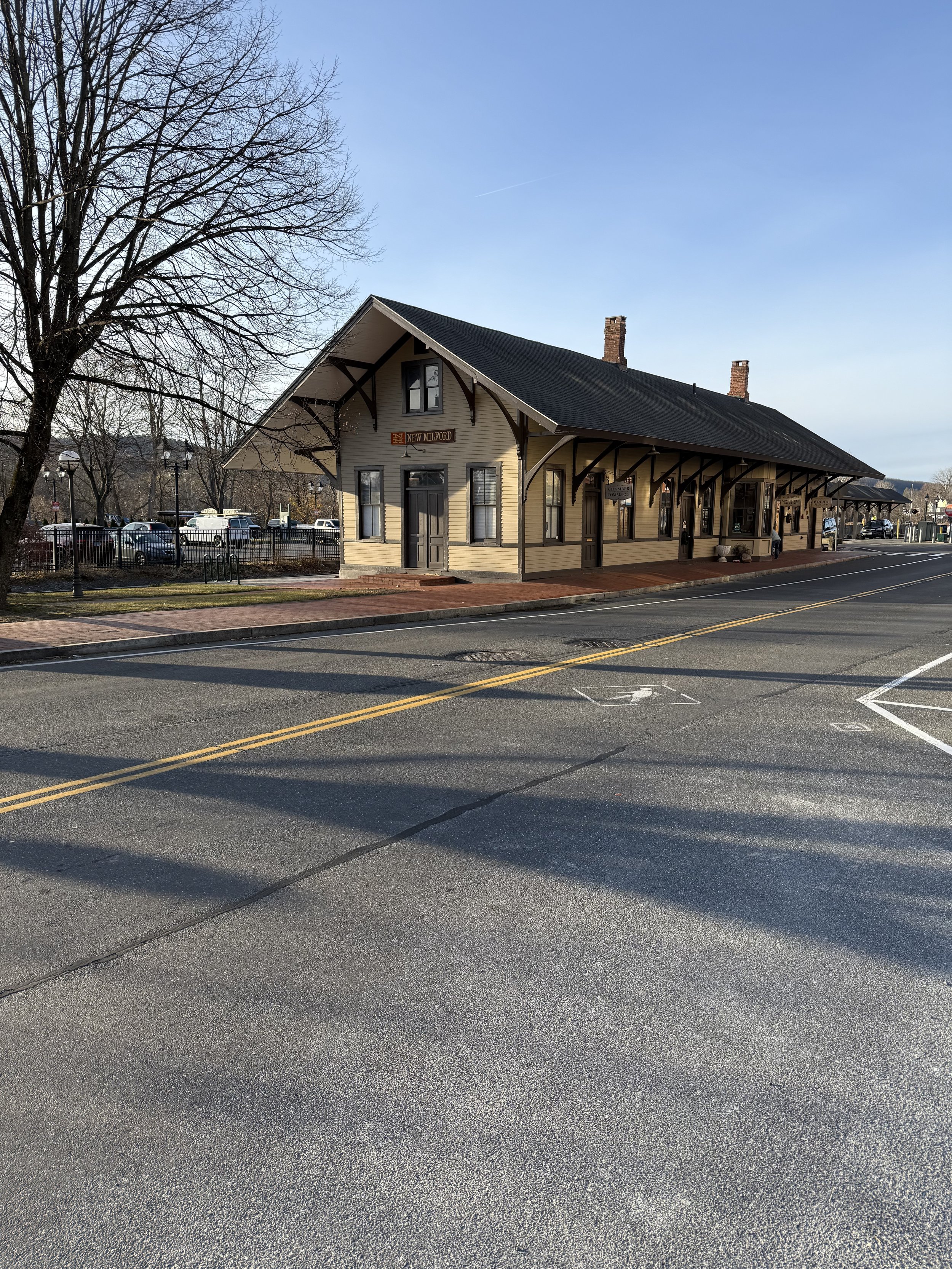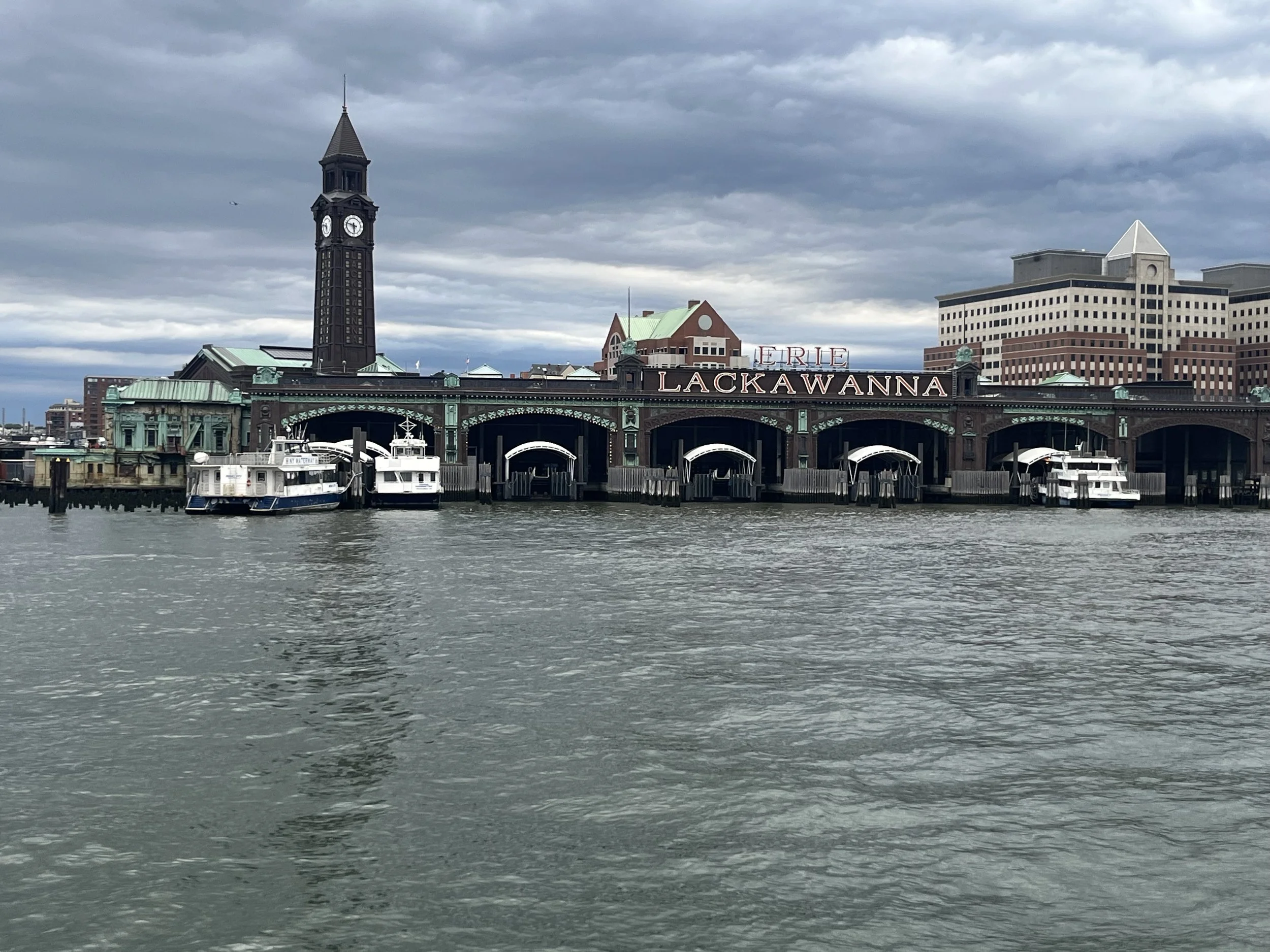Railroad Stations and Trains - Pictures, Narratives, and Commentary

New Milord, CT (New Haven Railroad) - no longer in use as a railroad station, but there is discussion about restoring service from Danbury, CT via the Metro North railroad which is on a branch line off the Metro North New Haven Line

Grand Central Terminal, New York, NY (originally served New York Central and New Haven Railroads, now serves Metro North and Long Island Railroads)

Hoboken Terminal, Hoboken, NJ (originally served Erie Lackawanna Railroad, now serves NJ Transit trains and NY Waterway ferries)

Harrisburg Transportation Center, Harrisburg, PA (originally severed Pennsylvania Railroad, now serves Amtrak)

Norfolk and Western #611 at rest in early morning at Goshen, VA prior to excursion to Staunton, VA

Reading and Northern #2102 (formerly of Reading Railroad) getting reading to depart from Pittston, PA for Nesquehoning, PA (the return trip of a Reading Rambles excursion)
Commentary on USA High Speed Rail
I recently drove Interstate 80 from New Jersey to Colorado; as I drove, I could not stop thinking about how much opportunity there is for building a high speed rail network in the United States, particularly along roughly the same corridor that I80 runs. Much of the terrain beyond Pennsylvania is quite flat and this is where it struck as a perfect opportunity for high speed rail. Western Illinois, all of Indiana and Nebraska is almost totally flat. The flat terrain is perfect for a highway and would be equally perfect for a railway.
All along the interstate highway system, one sees signs noting the Eisenhower Interstate System. The highways are an engineering marvel that President Dwight Eisenhower signed into law in the 1950s at a cost of two billion dollars. Before the interstates were built, there was a massive network of railways across America. All of those railways were built by private companies, along much of the infrastructure necessary to support them. Today, it is still possible to travel across the country by train along routes established by those private rail companies. However, it takes days to complete the journey because of the route the lines follow and Amtrak trains are only permitted to travel at a top speed of 79mph; much of the time, they average considerably less than that.
One of the things that also struck me as I drove along Interstate 80 was that almost all the traffic on the highway was trucks. This is also true of many of the other interstate highways in the United States; only when one is driving through or around cities does the car traffic increase. Would more people visit places like Colorado if it was easier and quicker to get to? Yes, there are plenty of regional airports serving many municipalities in the United States. But, domestic travel can often take just as long driving due to layovers, time to get to the airport, and time required to pass through airport security. There are minimal security checks at train stations and those stations are typically located in or near the center of town.
It took me 48 hours to drive from the time we left New Jersey to reach the Colorado-Nebraska border. It was 2079 miles from my house in Pennsylvania to the Golden Gate Canyon State Park near Golden, CO, where we spent the night. A train traveling at 186mph, which is considered true high speed, would cover the same distance in approximately 11 hours nonstop. The trip from Chicago to Denver on Amtrak takes 36 hours. Amtrak does not serve Golden, CO or Boulder, CO which, like many good sized American cities, were once served by passenger rail.
Building a high speed network rail infrastructure across the United States would likely be considered an engineering marvel, just as most other developed countries have done and the railroad companies did in the late nineteenth and early twentieth centuries. China has built high speed rail lines linking major cities; those lines have built primarily within the last 20 years and are considered an engineering marvel. Much of the rail infrastructure that still exists in the United States is also considered as such. Consider place like the Horseshoe Curve near Altoona, PA and the Moffat Tunnel passing through the Rocky Mountains in Colorado.
There are some higher speed rail, generally considered 125mph, networks starting to emerge in the United States. Brightline, a private company has already build a line link Miami, FL to Orlando Airport that will eventually extend to Tampa, FL via downtown Orlando and Disney Springs. The same company is also beginning to build a line from Rancho Cucamango, CA to Las Vegas, NV. Interestingly, this rail line will be built primarily in the median of Interstate 5 which links Los Angeles, CA to Las Vegas, NV. Amtrak has the Acela train that is capable of reaching speeds up to 186mph, yet the train can only run at speeds of around 125mph on a few portions of the route it travels on the Northeastern Corridor between Washington, DC and Boston, MA. The Brightline trains can also only travel at speeds of around 125mph on certain portions of the line due to infrastructure limitations such as grade crossings and parts of the line are shared with freight railways.
The main reason that the Acela train cannot travel at top speed along much of the line is because the railway was not built for high speed. Though Amtrak owns the line between Washington and Boston, the line was built in the 1900s by companies like the Pennsylvania Railroad and the New Haven Railroad. Like many of the railroads that were built across the United States the line follows rivers and north of New York skirts the ocean. It is very likely that rail companies used rivers to build their lines because the topography made it much easier. But of course, rivers are not straight and high speed rail needs to be straight and flat.
Outside of the Northeast Corridor and a few other places, Amtrak shares the rail lines with freight traffic. As a result, the freight trains are given priority so Amtrak trains must often slow down or pull into a siding to let the other train past. The railways that companies were built to haul freight, which in those days was such valuable commodities as coal or lumber. The companies had a significant passenger volume, but their major revenue came from hauling freight; so, the rail lines were not built to handle trains traveling at speed. However, the companies did give trains like the 20th Century Limited priority over freight. The 20th Century Limited was a train operated by the New York Central Railroad; it ran between New York and Chicago in a time of around 19 hours. The train was the height of luxury, as were many other famous passenger trains of the time, and it was said that one could set their watch by when the train would arrive or pass through - punctuality was paramount. Amtrak’s Lake Shore Limited runs on the same route and is advertised as taking 19 hours, but often takes more due to delays caused by freight traffic.
As I drive any interstate highway, I often wonder about the political will that existed in the 1950s that helped Eisenhower pass the Interstate Highway Act. Around the same time, passenger rail stared to decline as more people took to traveling by cars. The tire companies and oil companies were influential in the development of the highways. The federal government also began subsidizing air travel as a new means of transportation and, as a result, air travel across the country became more popular because it was touted as faster than trains. By the late 1960s, almost all passenger rail in the United States was gone. What would have happened if the federal government had invested as much into Amtrak as it has in highways and air travel? Surely, the federal government owns a significant right of way along the interstate highways. I cannot help wondering how easy it would be to build a high speed rail network parallel to the highways, particularly along ones like I80 that are flat and straight for thousands of miles.
Trains are considerably more efficient and environmentally friendly than cars or planes. Trains wouldn’t impact farmland or create noise pollution in towns they pass through. The noise of a train passing at high speed sounds like wind. Highways are often backed up with traffic passing through major metropolitan areas or are clogged with truck traffic. State and city governments are still responding to the issue of traffic by expanding roadways. Building railways would be a better answer and leave the highways for trucks that need them to quickly move goods across the country. A high speed rail network would connect city pairs just as easily as the interstate highway system has.